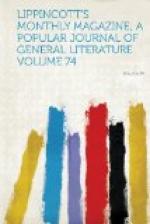In the solution of it there is no exaggeration in saying that the Centennial stands more than a quarter of a century in advance of even the latest of its fellow expositions. At Vienna a river with a few small steamers below and a tow-path above represented water-carriage. Good railways came in from every quarter of the compass, but none of them brought the locomotive to the neighborhood of the grounds. In the matter of tram-roads for passengers the Viennese distinguished themselves over the Londoners and Parisians by the possession of one. In steam-roads they had no advantage and no inferiority. At each and all of these cities the packing-box and the passenger were both confronted by the vexatious interval between the station and the exposition building—often the most trying part of the trip. Horsepower was the one time-honored resource, in ’73 as in ’51, and in unnumbered years before. Under the ancient divisions of horse and foot the world and its impedimenta moved upon Hyde Park, the Champ de Mars and the Prater, the umbrella and the oil-cloth tilt their only shield against Jupiter Pluvius, who seemed to take especial pleasure in demonstrating their failure, nineteen centuries after the contemptuous erasure of him from the calendar, to escape his power. It was reserved for the Philadelphia Commission to bring his reign (not the slightest intention of a pun) to a close. The most delicate silk or gem, and the most delicate wearer of the same, were enabled to pass under roof from San Francisco into the Main Building in Fairmount Park, and with a trifling break of twenty steps at the wharf might do so from the dock at Bremen, Havre or Liverpool. The hospitable shelter of the great pavilion was thus extended over the continent and either ocean. The drip of its eaves pattered into China, the Cape of Good Hope, Germany and Australia. Their spread became almost that of the welkin.
Let us look somewhat more into the detail of this unique feature of the American fair.
Within the limits of the United States the transportation question soon solved itself. Five-sixths of the seventy-four thousand miles of railway which lead, without interruption of track, to Fairmount Park are of either one and the same gauge, or so near it as to permit the use everywhere of the same car, its wheels a little broader than common. From the other sixth the bodies of the wagons, with their contents, are transferable by a change of trucks. The expected sixty or eighty thousand tons of building material and articles for display could thus be brought to their destination in a far shorter period than that actually allowed. Liberal arrangements were conceded by the various lines in regard to charges. Toll was exacted in one direction only, unsold articles to be returned to the shipper free. As the time for closing to exhibitors and opening to visitors approached the Centennial cars became more and more familiar to the rural watcher of the passing train.




